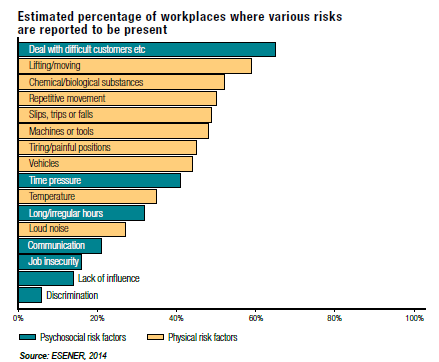Psycho-social risks
It is important for both employers and employees to thoroughly know the valid legal regulations about assessing stress at work. The stress at work is examined as a psychosocial risk factor, since it is not only an individual but also an organisational problem.

A number of risk factors may affect the employees at work which, if they persist, can lead to a workplace accident, or some kind of physical or psychologicaly originated illness. A 2014 national survey of workplaces employing 5 or more employees asked about the presence of selected physical and psychosocial risk factors in the workplace.
The most commonly cited risk factor across all workplaces was: ‘Dealing with difficult customers, patients, pupils etc.’, present in about two-thirds of workplaces with 5 or more employees. Further stressors are overwork, lack of recognition, frequent changes in roles, too much responsibility without appropriate rewards, insecurity and poor working environment.
The statutory framework (in UK): Health and Safety at Work etc Act 1974 and the Management of Health and Safety at Work Regulations, 1999.
The Health and Safety Executive (in UK) defines stress as “the adverse reaction people have to excessive pressure or other types of demand placed on them.” This makes an important distinction between pressure that can be positive if managed correctly, and stress that can be detrimental to health.
The EU Framework Directive on Safety and Health at Work (Directive 89/391/EEC) and its individual directives provide the framework for workers in Europe to enjoy high levels of health and safety at work.
Stress-Management Barometer:
Online stress assessment system is able to assess the potential psychosocial risks at the workplace. At the individual level the results give an up-to-date and comprehensive picture of the situation examined in the organisation, of the impact of organisational processes on the employees.

